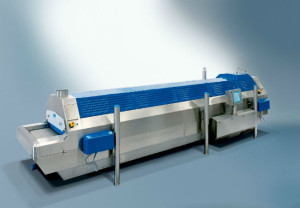By Melanie Epp, Contributing Writer
Earlier this year, Linde showcased advanced cryogenic freezing solutions at the Anuga FoodTec trade fair in Cologne, Germany. The company received an International FoodTec Silver Award for its latest freezing technology, an integrated immersion/tunnel freezer for individually quick frozen (IQF) products, the CRYOLINE SI, to be released in early 2016.
While the CRYOLINE SI is the latest technology to be unveiled, Steve McCormick, head of food and beverage global at Linde, said that it’s not the most suitable product for U.S. food processors. It was, in fact, designed with the smaller- scale European market in mind. There are, however, two technologies that were designed specifically with large-scale U.S.- based operations in mind: CRYOLINE CW, a multipurpose freezer, and the Nitrogen Immersion Freezer.
Nitrogen Immersion Freezer
Linde’s Nitrogen Immersion Freezer is most broadly utilized in the fruit and vegetable market. The technology is used not to freeze product completely, but more as a pre-freezer, quickly crusting the product to lock moisture in. It has been used for frozen fruit and vegetable products, such as spinach, peas, corn, rice, blueberries, strawberries, cranberries, cherries, peppers, diced onions and mushrooms.
There are advantages to using pre-freezing technology, McCormick said. Locking in moisture helps not only preserve yield, but preserves quality – flavor and nutritional content – as well.
Take spinach, for example, which McCormick said has a moisture content of 92 percent. Typically, leafy products like spinach are diced during processing. Unavoidably, the process means cutting through membranes, which causes water to bleed out. When the product goes through a standard mechanical refrigeration unit, the cold air tends to wick the moisture out, causing dehydration to occur.
“You can lose up to 15 percent of the total moisture content in a standard mechanical refrigeration system,” McCormick said.
To mitigate this problem, processors can put an immersion unit, like the Nitrogen Immersion Freezer, in front of the mechanical unit and drop the product into a nitrogen immersion bath to seal the surface.
“When the leaves drop into the nitrogen immersion bath it seals the surface of the leaf, locking in 100 percent of the moisture, and in some cases even locking a bit of surface moisture onto the product,” McCormick said. “Now you can go through your mechanical refrigeration system and lose no moisture.”
In addition, the Immersion freezer can help boost the production capacity of the mechanical refrigeration unit by removing a portion of the latent heat of freezing from the food product.
Depending on the unit and the product being processed, the Nitrogen Immersion Freezer has a capacity of about five tons per hour. It’s available in multiple lengths, up to 24 feet, which creates tremendous capacity for maximum throughput. Linde can also custom-build machines to meet individual processor’s needs.
CRYOLINE CW multipurpose freezer
The patented CRYOLINE CW is a unique multipurpose freezer, a modular unit that utilizes two zones within a single freezer compartment. The front zone uses controllable vibration technology in its conveyor belt, which creates a wavelike motion along the length of the conveyor. As the product moves along the conveyor, the wavelike motion not only keeps product from sticking to its belt surface, but also from sticking to surrounding product. The combination of both the movement and the cryogen locks in valuable moisture, which helps to preserve product yield and quality.
The CRYOLINE CW offers flexibility in terms of the cryogenic medium it uses as well. Processors can choose between liquid nitrogen and carbon dioxide. While most CRYOLINE CW units fully freeze product, they can also be used for crust freezing prior to another freezing system, McCormick said.
Originally designed for the Southeast Asian seafood market, the CRYOWAVE is designed to be the solution for processors who want to freeze individually pieced products in bulk. This is especially useful for product that is to be bulk packed, but whose end users want to be able to remove portions as necessary without having to defrost the entire package.
“With some types of freezing systems, what you’re going to get is a lot of product all lumped together,” McCormick said. “And that’s pretty wasteful for a restaurant situation.”
Since it was introduced in 2005, the multipurpose freezer has been used for a variety of products, including mushrooms, diced onions, diced tomatoes, mango, papaya and orange and lemon slices.
By disengaging the vibration motion in front, the CRYOLINE CW has the flexibility to operate as a standard tunnel freezer as well. The CW is available with a base freezer of 5 meters (16.4 feet) in overall length and a belt width of 42 inches. It offers options of 3-meter (9.8 feet) extensions to a maximum of 14 meters (45.9 feet). In terms of capacity, a 5-meter unit can process between one half ton to three-quarters of one ton of product per hour. At its maximum, it can process three and one half tons per hour when used to fully freeze.
Ease of cleanliness a key feature
Both the CRYOLINE CW and the Nitrogen Immersion Freezer are designed with ease of cleanliness in mind, a feature that some processors may find particularly welcome. The freezer tops lift vertically, providing full access for cleaning.
Both units are made entirely of stainless steel and fully welded throughout, leaving no open seams. The advantage of this, said McCormick, is that there are no crevices in which bacteria can get trapped. Finally, both units have been designed with sloping floors and center-trough drainage, so water is easily removed once clean.

